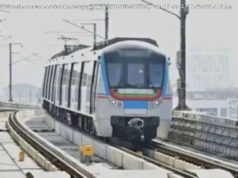Light rail is a very expensive way to move very few commuters.
Nashville’s singers and songwriters have long liked to write about pickup trucks. Light rail? Not so much. And the city’s voters seemed to share this distaste when they went to the polls last month. They faced a choice encountered by people in dozens of U. S. cities in recent years: Would they hike their taxes to pay for a rail system?
Music City’s political and business leaders were pushing an $8.9 billion plan to build four light-rail lines connecting the county’s outskirts to its honky-tonk-lined downtown. The plan, they said, would help the environment, provide alternatives to traffic congestion, and show Nashville to be “forward-thinking and good hearted.”
Against them was an unusual coalition of African-American voters and anti-tax activists worried about its cost. A “yes” vote would have made Nashville’s sales tax the highest in the country, at more than 10 percent.
The campaign had several bizarre turns. The city’s Democratic mayor, a strong transit booster, resigned two months before the vote after being caught in a sex scandal with her police bodyguard. Transit opponents were accused of taking “dark money” from the nefarious Koch brothers. When the polls closed May 1, though, the results weren’t close. The transit plan lost 2-to-1.
Light rail is having a tough time nationally. City leaders across the country might embrace it, but commuters keep favoring cars. Ridership is down—even though the two-dozen cities with light-rail systems are generally prosperous and growing and are adding more miles of tracks.
As fewer people ride the trains, though, Washington keeps the money flowing. A Trump administration proposal to slash transit funding and require cities to pick up more of the tab is headed nowhere—even in a Republican-controlled Congress. Members from both parties are pressing administration officials to sink additional federal money into light-rail projects. The Transportation Department typically subsidizes up to half of a light-rail system’s capital costs.
The main knock on light rail is that it is an expensive way to move very few commuters. Light rail makes sense for people who live near a line and work downtown. The trouble is that in most cities, the vast majority of jobs are located outside of the city center and most commuters live nowhere near the rail stations. Nashville, for instance, has about 67,000 workers downtown in a metro area of about 1.9 million. Even in cities where light rail is touted as a success, such as Portland, Ore., light rail accounts for just 0.9 percent of miles traveled.
Mass transit does best in cities with big downtowns that were built when riding buses, streetcars, or trains was the main way to get around—that is, before cars were popularized after World War II. Transit accounts for 12 percent of miles traveled in New York City and 7 percent in San Francisco. Urban areas that sprang up in the second half of the 20th century lack the population density needed to make mass transit a cost-effective option for most of their residents.
About 70 percent of transit referendums pass, on average. Lately, though, communities have been hitting the brakes. Besides Nashville’s recent no, Virginia Beach voters shot down light rail in 2016. Elected officials in Tampa this year are pushing for more buses, following a string of votes in the last decade in which residents opted not to trade sales-tax increases for light rail. It’s the same in San Antonio, where voter skepticism over light rail led local officials to push a transit plan that relies on souped-up buses that resemble train cars. On May 1, the city’s mayor told the local paper, “We have the opportunity to be innovators rather than last in line for old technology.… We are beyond light rail. The world is beyond light rail.”
Light-rail advocates proclaim that it is environmentally friendly for pulling cars off the roads, that it creates jobs, and that it encourages economic development. They rarely say it will reduce traffic congestion, because traffic only increases in fast-growing cities. “The pitch usually is ‘Congestion is terrible. It’s going to get worse. We have to do something. This is something. Let’s do it,’ ” says Randal O’Toole, who studies transportation and land use at the libertarian Cato Institute. “They have to strongly imply it will reduce congestion. They say it provides an alternative to congestion, but it’s an alternative hardly anybody uses.” O’Toole points out that congestion pricing and synchronizing stoplights can help mitigate heavy traffic much more cost-effectively than multibillion-dollar light-rail systems.
Then there is the question of ride-sharing services and driverless cars. Uber averages 15 million rides a day. Lyft averages more than 1 million. Together, that’s nearly 6 billion trips a year—more than 10 times the number of U. S. light-rail rides last year. And these services are growing quickly. A study last year by the University of California Davis’s Institute of Transportation Studies found that once people try ride-sharing, they become 3 percent less likely to ride light rail and 6 percent less likely to ride buses. The most common reasons cited were that mass transit is too slow, that there aren’t enough stops or stations, and that no transit services are available when traveling.
The ongoing experiments with self-driving vehicles suggest an answer to such complaints. Such cars could make driving more efficient, with fewer accidents and less congestion, and poach even more riders from mass transit. “With this pending technological disruption, do we really want to be investing in legacy infrastructure?” asks Aaron Renn, who studies transportation and economic development at the Manhattan Institute, a free-market think tank. “I’d be arguing the same thing with roads. Do we really want to be building a massive amount of roads when we don’t know what’s going to happen with driverless cars?”
The American Public Transportation Association (APTA), which represents transit agencies, private bus and rail makers, and related businesses, says it sees no crisis in light rail. Eleven of the nation’s 29 light-rail systems had ridership increases in 2017, according to APTA figures. Nationally, ridership fell about 1 percent. Darnell Grisby, APTA’s director of policy development and research, says ridership last year was “flat” but that it came after years of ridership gains. Low gas prices played a role, he thinks. “Ridership is cyclical in nature,” Grisby says. “Ridership has been high over the last 10 years. There has been a great momentum in increased ridership in public transportation. The trend is still up.”
The future for transit is strong, he says, because innovative transit systems are partnering with the ride-sharing companies. The two types of transportation can be complementary, not competitive, he believes. He points to the example of St. Petersburg, Fla., which started a program to replace little-used bus routes with subsidized Uber rides.






